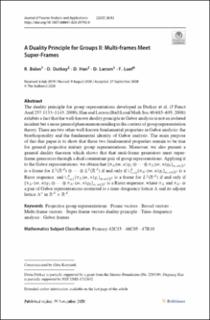| dc.contributor.author | Balan, Radu | |
| dc.contributor.author | Dutkay, Dorin | |
| dc.contributor.author | Han, Deguang | |
| dc.contributor.author | David, Larson | |
| dc.contributor.author | Luef, Franz | |
| dc.date.accessioned | 2021-01-19T14:16:55Z | |
| dc.date.available | 2021-01-19T14:16:55Z | |
| dc.date.created | 2020-11-10T12:33:13Z | |
| dc.date.issued | 2020 | |
| dc.identifier.issn | 1069-5869 | |
| dc.identifier.uri | https://hdl.handle.net/11250/2723738 | |
| dc.description.abstract | The duality principle for group representations developed in Dutkay et al. (J Funct Anal 257:1133–1143, 2009), Han and Larson (Bull Lond Math Soc 40:685–695, 2008) exhibits a fact that the well-known duality principle in Gabor analysis is not an isolated incident but a more general phenomenon residing in the context of group representation theory. There are two other well-known fundamental properties in Gabor analysis: the biorthogonality and the fundamental identity of Gabor analysis. The main purpose of this this paper is to show that these two fundamental properties remain to be true for general projective unitary group representations. Moreover, we also present a general duality theorem which shows that that muti-frame generators meet super-frame generators through a dual commutant pair of group representations. Applying it to the Gabor representations, we obtain that \{\pi _{\Lambda }(m, n)g_{1} \oplus \cdots \oplus \pi _{\Lambda }(m, n)g_{k}\}_{m, n \in {\mathbb {Z}}^{d}} is a frame for L^{2}({\mathbb {R}}\,^{d})\oplus \cdots \oplus L^{2}({\mathbb {R}}\,^{d}) if and only if \cup _{i=1}^{k}\{\pi _{\Lambda ^{o}}(m, n)g_{i}\}_{m, n\in {\mathbb {Z}}^{d}} is a Riesz sequence, and \cup _{i=1}^{k} \{\pi _{\Lambda }(m, n)g_{i}\}_{m, n\in {\mathbb {Z}}^{d}} is a frame for L^{2}({\mathbb {R}}\,^{d}) if and only if \{\pi _{\Lambda ^{o}}(m, n)g_{1} \oplus \cdots \oplus \pi _{\Lambda ^{o}}(m, n)g_{k}\}_{m, n \in {\mathbb {Z}}^{d}} is a Riesz sequence, where \pi _{\Lambda } and \pi _{\Lambda ^{o}} is a pair of Gabor representations restricted to a time–frequency lattice \Lambda and its adjoint lattice \Lambda ^{o} in {\mathbb {R}}\,^{d}\times {\mathbb {R}}\,^{d}. | en_US |
| dc.language.iso | eng | en_US |
| dc.publisher | Springer | en_US |
| dc.rights | Navngivelse 4.0 Internasjonal | * |
| dc.rights.uri | http://creativecommons.org/licenses/by/4.0/deed.no | * |
| dc.title | A Duality Principle for Groups II: Multi-frames Meet Super-Frames | en_US |
| dc.type | Peer reviewed | en_US |
| dc.type | Journal article | en_US |
| dc.description.version | publishedVersion | en_US |
| dc.source.volume | 26 | en_US |
| dc.source.journal | Journal of Fourier Analysis and Applications | en_US |
| dc.source.issue | 83 | en_US |
| dc.identifier.doi | 10.1007/s00041-020-09792-0 | |
| dc.identifier.cristin | 1846526 | |
| dc.description.localcode | Open Access This article is licensed under a Creative Commons Attribution 4.0 International License, which permits use, sharing, adaptation, distribution and reproduction in any medium or format, as long as you give appropriate credit to the original author(s) and the source, provide a link to the Creative Commons licence, and indicate if changes were made. The images or other third party material in this article are included in the article’s Creative Commons licence, unless indicated otherwise in a credit line to the material. If material is not included in the article’s Creative Commons licence and your intended use is not permitted by statutory regulation or exceeds the permitted use, you will need to obtain permission directly from the copyright holder. To view a copy of this licence, visit http://creativecommons.org/licenses/by/4.0/. | en_US |
| cristin.ispublished | true | |
| cristin.fulltext | postprint | |
| cristin.qualitycode | 2 | |

